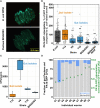Host Preference of Beneficial Commensals in a Microbially-Diverse Environment
- PMID: 35782135
- PMCID: PMC9240469
- DOI: 10.3389/fcimb.2022.795343
Host Preference of Beneficial Commensals in a Microbially-Diverse Environment
Abstract
Gut bacteria are often described by the neutral term commensals. However, the more we learn about their interactions with hosts, the more apparent it becomes that gut commensals often contribute positively to host physiology and fitness. Whether hosts can prefer beneficial bacteria, and how they do so, is not clear. This is of particular interest in the case of the bacterivore C. elegans, which depends on bacteria as food source, but also as gut colonizers that contribute to its physiology, from development to immunity. It is further unclear to what extent worms living in their microbially-diverse habitats can sense and distinguish between beneficial bacteria, food, and pathogens. Focusing on Enterobacteriaceae and members of closely related families, we isolated gut bacteria from worms raised in compost microcosms, as well as bacteria from the respective environments and evaluated their contributions to host development. Most isolates, from worms or from the surrounding environment, promoted faster development compared to the non-colonizing E. coli food strain. Pantoea strains further showed differential contributions of gut isolates versus an environmental isolate. Characterizing bacterial ability to hinder pathogenic colonization with Pseudomonas aeruginosa, supported the trend of Pantoea gut commensals being beneficial, in contrast to the environmental strain. Interestingly, worms were attracted to the beneficial Pantoea strains, preferring them over non-beneficial bacteria, including the environmental Pantoea strain. While our understanding of the mechanisms underlying these host-microbe interactions are still rudimentary, the results suggest that hosts can sense and prefer beneficial commensals.
Keywords: C. elegans; Enterobacteriaceae; Pantoea; commensal; microbiota; preference.
Copyright © 2022 Pérez-Carrascal, Choi, Massot, Pees, Narayan and Shapira.
Conflict of interest statement
The authors declare that the research was conducted in the absence of any commercial or financial relationships that could be construed as a potential conflict of interest. The reviewer MP declared a shared affiliation with the authors to the handling editor at the time of review.
Figures



References
-
- Adeolu M., Alnajar S., Naushad S., S. Gupta R. (2016). Genome-Based Phylogeny and Taxonomy of the ‘Enterobacteriales’: Proposal for Enterobacterales Ord. Nov. Divided Into the Families Enterobacteriaceae, Erwiniaceae Fam. Nov., Pectobacteriaceae Fam. Nov., Yersiniaceae Fam. Nov., Hafniaceae Fam. Nov., Morganellaceae Fam. Nov., and Budviciaceae Fam. Nov. Int. J. Syst. Evol. Microbiol. 66, 5575–5599. doi: 10.1099/ijsem.0.001485 - DOI - PubMed
Publication types
MeSH terms
Grants and funding
LinkOut - more resources
Full Text Sources

